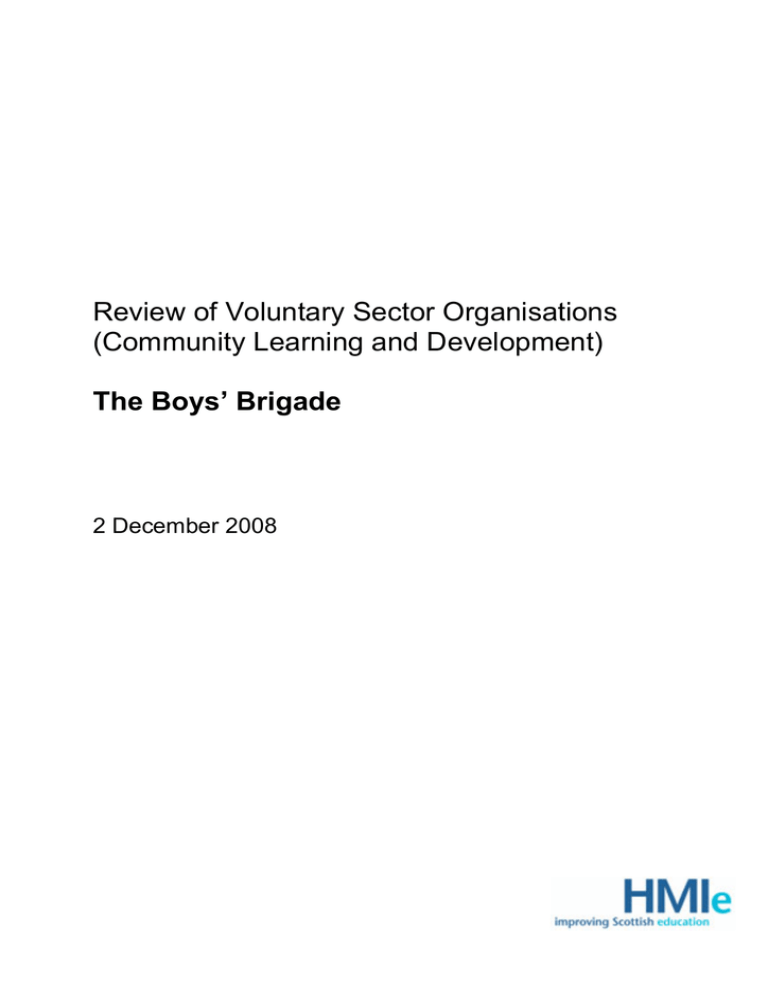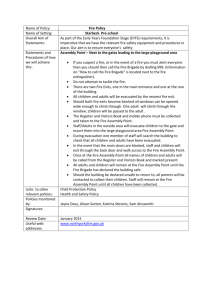Review of Voluntary Sector Organisations (Community Learning and Development) The Boys’ Brigade
advertisement

Review of Voluntary Sector Organisations (Community Learning and Development) The Boys’ Brigade 2 December 2008 Contents Page 1. Introduction 1 2. Context and background 1 3. Key strengths 2 4. How well did The Boys’ Brigade meet the needs of its stakeholders? 2 5. How effective was The Boys’ Brigade in key aspects of management? 4 6. How effective was the leadership of The Boys’ Brigade? 5 7. What is The Boys’ Brigade capacity to improve? 5 8. What happens next? 6 Appendix 1: Quality indicators used to evaluate The Boys’ Brigade 7 1. Introduction In September 2008, the Scottish Government (SG) commissioned HM Inspectorate of Education (HMIE) to undertake a review of The Boys’ Brigade (BB). HMIE and SG agreed the quality and performance indicators to be used in the review from the framework of indicators within the HMIE publication How Good Is Our Community Learning and Development?2 (HGIOCLD?2). The fieldwork for the review took place between 16 and 18 September 2008. A visit to a BB company in Dunfermline was undertaken to talk to stakeholders and participants. A series of interviews and focus groups were conducted with members of the BB Scotland Committee, managers and staff. Telephone interviews with stakeholders were also carried out. Questionnaires were distributed to key stakeholders across Scotland. Questionnaires were returned from 32 respondents. The BB provided a detailed self-evaluation in advance of the review, together with comprehensive supporting documentary evidence. The cooperation of committee members, managers, staff and stakeholders is gratefully acknowledged. 2. Context and background The BB is a voluntary uniformed youth organisation that was founded in 1883. The BB offers “any branch of the Christian church a method and structure for outreach to, and youth work with, boys and young people.” The BB operates across the United Kingdom, and there are companies in every area of Scotland. Its Scottish membership consists of over 18,800 young people in 462 companies. Companies are organised into 30 battalions, which cover areas similar to, but not co-terminus with, local authority boundaries. Its mission statement indicates that, the “BB will care for and challenge young people for life through a programme of informal education underpinned by the Christian faith.” The BB operates five sections according to age ranges. • Anchor Boys Primary 2 and 3. • Junior Section Primary 4, 5 and 6. • Company Section Primary 7, Secondary years 1, 2 and 3 up to age 15. • Seniors Age 15 until the end of the school session during which they reach 18. • Amicus Young people from 15 to 22. The BB in Scotland has four full-time staff based in its headquarters (HQ); a director, a training and development officer, and two administrative staff. There is also a part-time administrative assistant. The BB in Scotland also operates a residential 1 and conference centre, Carronvale House, which employs three full-time staff and six part-time staff. Carronvale House operates on an independent financial basis. HQ services are primarily delivered through the battalion network, but services are offered direct to members and companies through use of new technology. Many financial and administrative functions are centralised within the UK HQ, as is programme and service development. The Scotland Committee, comprising elected representatives from companies and battalions and Scottish staff, oversee BB developments in Scotland. Four representatives of the Scotland Committee were members of the BB National Executive. All BB companies and battalions are run by volunteers. 3. Key strengths The review of the BB in Scotland identified the following strengths: • a highly committed group of Scotland Committee members who brought with them a good range of professional skills and a clear understanding of their responsibilities; • staff and managers were highly committed and motivated; • effective structures in place to ensure young people under 26 had a voice in organisational decision making; • King George VI Officer Cadet Scheme actively encouraged young people to take on a leadership role; • BB HQ support was highly valued by stakeholders; and • increased participation in Presidents and Queen’s badges against a backdrop of declining membership. These are the highest awards in the BB and are open to young people who are in S3 at school or older. 4. How well did The Boys’ Brigade meet the needs of its stakeholders? How well did the BB impact on young people? Young people involved in the BB increased their confidence by taking part in a number of activities such as challenging expeditions and trips to other parts of Scotland and to European countries. Others had worked with the elderly, in hospitals and within their communities. All of these activities involved working regularly as part of a team. Despite falling membership overall, there had been a steady increase in participation in both the Presidents and Queens awards. Many young people had developed their musical and sporting abilities within their BB companies and played regularly in public performances. Young people progressed from these activities to taking on responsible roles within BB companies. The numbers of young people who had gained awards such as The Duke of Edinburgh’s 2 Award and the Queen’s Award had increased over the last five years. Each year a number of experienced members took part in a challenging leadership training programme as part of the King George VI Officer Cadet Scheme. Others had joined the under 26 group which now helped to support the work of the Brigade’s Scottish Committee. Features of good practice: The King George VI Officer Cadet Scheme The King George VI Officer Cadet Scheme was an intensive two year leadership programme for senior members. Young people actively engaged in the structured programme which encouraged and developed team working. The programme acted as a successful in-house mechanism for growing and retaining future company leaders. Young people progressed to take on leadership roles within companies. This was supporting the future survival of local companies. Positive impact of skills learned noted by individuals, and brigade leaders. Young leaders were also applying leadership skills gained within their place of employment. More detailed information is available at www.hmie.gov.uk. How well did the BB impact on communities? Young people involved in the BB were active members of their communities. Many had their contributions recognised by awards in the Millennium Volunteer Scheme. They participated in major fundraising activities for local and national charities such as the Royal National Lifeboat Institution and the Children’s Hospice Fund as part of their work with the Brigade. Young people helped to organise national Brigade events such as the Crossover Festival and the BB Games. A Scottish Brigade company with younger members had won a UK award for designing their company website. Young people from across Scotland and from many faiths and ethnic groups participated in the work of the BBs. There were good links to other organisations such as the police, the Church of Scotland and health agencies. Young members of the under 26 group were now helping the Brigade’s Scottish Committee in developing the work of the BB for the 21st century. There was a need for the BB to improve how it recorded and publicised its work on the difference its members were making to their communities across Scotland. Impact on paid and voluntary staff Managers and staff at BB HQ were motivated and committed to their work. Staff morale was good. Carronvale House staff had successfully undertaken a range of accredited staff development courses. The annual appraisal system was well structured with clear guidelines in place. A new development programme for over 16s had been developed based on research undertaken at local, area and national level. The organisation provided good quality information to its membership through quarterly magazines and the website. The Brigade Training Officer scheme effectively delivered certificated Scottish Vocational Qualification (SVQ) courses. Brigade leaders received quality training in respect of safety relating to camps and expeditions. An extensive training programme supported young people to become volunteers. This was highly valued by participants. Young people had progressed to be trainers in their workplace or in further study. The BB had a comprehensive 3 safety handbook for company captains in place and was currently disclosure checking all new applicants. There were, however, still some officers, of long standing who had not been checked. This should be addressed as a matter of urgency. There was no formal support and supervision system operating for HQ staff. Evaluation of training was recognised by the organisation as not being fully systematic. External training was under-developed. Battalion training programmes needed to be more responsive to local needs. 5. How effective was The Boys’ Brigade in key aspects of management? Inclusion, equality and fairness The organisation had an equalities policy in place. One Glasgow company engaged effectively with young asylum seekers from over 15 different countries and religious faiths. Other local companies had successfully fundraised to support young asylum seekers in securing uniforms. Young adults with severe learning disabilities were actively involved in a company in Bridge of Weir. The Duke of Edinburgh open award unit supported girls to complete their gold award. Changes in the constitution required equal numbers of under 26 year olds to be elected as members to the Brigade Committee. These changes were in the early stages of being introduced. Research targeting the perceptions of 12 to 16 year olds had recently been completed. However, the organisation recognised the need to target and engage more effectively with disaffected young people. The lack of a current media profile and out of date public perception did not assist the development of the organisation. The findings of the research and introduction of an inner city project worker were not yet far enough progressed to see tangible impact. Participation of service users and other stakeholders The Scottish Committee of BB and the leaders of each Brigade company were volunteers. The representatives to the Committee came from across Scotland and included women and young people. The Committee had commissioned research into the changing needs of young people today. They had actively sought to offer improved opportunities for Brigade Officers and young people to participate in the development of the organisation. Volunteers took part in the Visions to Reality conferences and seminars to discuss how to develop the BB for the 21st century. Young people in Brigades from across the country were participating in the under 26 committee. Others took on roles as junior office holders in Brigades and got involved in charitable fundraising. Volunteer leaders of companies said they were listened to in the development of the organisation. They took part in the Annual Gathering and contributed to debates and discussions. The BB had well developed training programmes to support both young members and volunteers to gain leadership skills and involve themselves in the work and life of the organisation. The Scottish Committee was well supported by working parties on areas of special interest such as training and financial management. There were opportunities to develop further the communication systems to volunteers to support the regular magazine and website. 4 Operational planning The UK business plan clearly set out relevant actions against agreed aims. This formed the basis of organisational planning across the UK. Local working groups highlighted developments in response to identified issues. All activity in the 2003 to 2008 business plan had been updated to reflect progress made. This informed the new business plan for period 2008 to 2013. Arising from the Visions into Reality exercise, 24 out of 30 Battalions had been supported to develop their own Battalion action plan. These followed an agreed format and reflected the Battalions own local priorities. The Visions into Reality conferences raised awareness and encouraged local ownership of the 2008 to 2013 development plan. The organisation was in the early stages of developing a two part audit to assist Battalions in their assessment of companies, and to support companies in undertaking their own self-assessment. The company development file offered an effective planning tool and structure for reviewing progress at a local level. However, no specific measureable outcomes had been set. There was no clear distinction in the business plan between outputs and outcomes and how success will be measured. There was no clear linkage to current SG policies for example on active citizenship. There was no specific Scottish HQ planning document and no detailed plans in place for working groups. HQ staff did not operate individual work plans or job targets. Self-assessment audit material remained at an early stage of development. 6. How effective was the leadership of The Boys’ Brigade? Scotland Committee members offered strong, active and challenging leadership with a good range of professional expertise. Committee members felt a strong sense of commitment to the BB and were clear about the important role the organisation was playing. The chair of the committee provided effective and clear leadership, supported well by the other office bearers. All HQ staff were enthusiastic and hard working. The Director and Training Officer worked in partnership with Scotland Committee members. Financial governance was very good. Effective financial systems ensured clear accountability. Scottish HQ had issued effective guidance to local companies on compliance with the requirements of the Office of the Scottish Charity Regulator (OSCR). Good use was made of income from the Carronvale residential centre to support BB weekend activities. The views and ideas of the under 26 representatives were valued within the Scotland Committee. They were actively engaged in improvement planning working groups. 7. What is The Boys’ Brigade capacity to improve? There is a strong commitment at both board and staff level to taking the organisation forward to meet the needs of its members. The organisation valued the views and input of its membership. However, Disclosure checks of all officers should be completed. Strategies for engagement with more excluded young people should be developed and implemented. The limited public profile of the organisation should be addressed. More outcome focussed planning would assist the organisation to meet its goals. 5 Based on the action points within this report being effectively undertaken HMIE is confident that BB HQ has the capacity to improve the impact it makes on its membership in Scotland. 8. What happens next? HMIE will take no further action in respect of this review and recommends that the BB HQ take action on the main points for action below. • Progress as a matter of urgency checking all company officers not subject of Enhanced Disclosure (Part V of The Police Act 1997). • Develop strategies for engaging with more excluded young people. • Further develop planning processes to better identify outputs, intended outcomes and success measures and links to SG priorities. • Introduce work plans for the Director and Training Officer. • Develop self-assessment materials and training in their use of battalion staff. • Improve the organisations’ media profile. Stewart Maxwell Managing Inspector HMIE 6 Appendix 1: Quality indicators used to evaluate The Boys’ Brigade HM Inspectors use performance measures and quality indicators when making judgements in their reviews of national voluntary organisations. The quality indicators used were selected from those published in June 2006 in the publication HGIOCLD?2. This publication is available on the website www.hmie.gov.uk. In the report and this appendix we make clear the judgements made by using these word scale categories: Excellent Very good Good Satisfactory Weak Unsatisfactory Outstanding, sector leading Major strengths Important strengths with some areas for improvement Strengths just outweigh weaknesses Important weaknesses Major weaknesses Improvement in performance Impact on participants Impact on staff and volunteers Impact on local communities Inclusion, equality and fairness Participation of service users / stakeholders Operational planning Developing leadership and direction 7 Good Very good Good Good Good Very good Good Very good How can you contact us? HMIE Feedback and Complaints Procedure Should you wish to comment on any aspect of community learning and development voluntary organisation reviews you should write in the first instance to Annette Bruton, HMCI, at HM Inspectorate of Education, Denholm House, Almondvale Business Park, Almondvale Way, Livingston EH54 6GA. If you have a concern about this report, you should write in the first instance to our Complaints Manager, HMIE Business Management Unit, Second Floor, Denholm House, Almondvale Business Park, Almondvale Way, Livingston, EH54 6GA. You can also e-mail HMIEComplaints@hmie.gsi.gov.uk. A copy of our complaints procedure is available from this office, by telephoning 01506 600200 or from our website at www.hmie.gov.uk. If you are not satisfied with the action we have taken at the end of our complaints procedure, you can raise your complaint with the Scottish Public Services Ombudsman (SPSO). The SPSO is fully independent and has powers to investigate complaints about Government departments and agencies. You should write to the SPSO, Freepost EH641, Edinburgh EH3 0BR. You can also telephone 0800 377 7330 (fax 0800 377 7331) or e-mail: ask@spso.org.uk. More information about the Ombudsman’s office can be obtained from the website: www.spso.org.uk. Crown Copyright 2008 HM Inspectorate of Education This report may be reproduced in whole or in part, except for commercial purposes or in connection with a prospectus or advertisement, provided that the source and date thereof are stated. 8




